The Air Force is closing in on 10 years at war in Afghanistan, and the unrelenting combat operations tempo actually stretches back much further—to the days of Operation Desert Storm in 1991. This is not a steady state, however—top Air Force leaders speaking at the Air Force Association’s Air Warfare Symposium in Orlando, Fla., this February said airpower is busier than ever in the ramped-up Operation Enduring Freedom campaign.
Air strikes and close air support sorties are reaching record highs, as US and NATO forces pound Taliban and militant sanctuaries across Afghanistan. In January 2011, NATO aircraft fired guns and dropped munitions during 387 sorties—up from 157 similar sorties in January 2010.
In the six months leading up to February 2011, allied air units flew 3,723 weapons sorties, while special operations raids increased and captured or killed thousands of militants. Airdrops and airlift routinely broke new records, as the raw airdrop poundage over Afghanistan has nearly doubled every year since 2006.
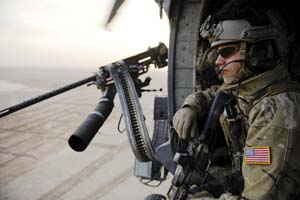 |
|
Attention to Afghanistan is balanced by the Air Force leadership’s desire to find a proper “balance” between investment tailored for current or future threats. This often manifests itself in debates over how to best address the problems with USAF’s beat-up legacy force structure.
Various commanders made clear they are dealing with a daunting range of new and emerging threats and strategic difficulties. The concerns range from instability and drug-, weapon-, and human-trafficking in South America, to missile defense cooperation in Europe, to the proliferation of anti-access and area denial weapons by “near peers” in the Pacific.
“It’s a critical time [for the Air Force], both operationally and fiscally,” said Air Combat Command’s Gen. William M. Fraser III. The Air Force must be prepared to win any manner of conflict, build lasting partnerships, and bring “unique and … tailored” effects to its different theaters of operation.
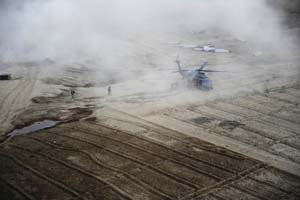 |
|
Afghan operations are performed in a permissive environment, several leaders noted, allowing US and allied forces to leverage their mastery of air and space. “Our ability to establish air dominance has been so powerful that it’s created expectations that are going to be difficult to back away from,” said Gen. Mark A. Welsh III, commander of US Air Forces in Europe.
Proliferating Threats
The proliferation of advanced technology raises concerns about how long the Air Force will enjoy air dominance. Within the last year, both Russia and China have unveiled stealth fighter variants publicly—first the Russians with the PAK FA beginning test flights in January 2010, then this past January, the Chinese with flight testing of their J-20 advanced fifth generation fighter.
“I don’t know what the actual capability of either of those new stealth platforms … is,” said Welsh. “It took us a long time to get from rollout to where we are today, so I suspect it will take them at least that long, if not longer. I know people can say that’s a dangerous assumption, but you have to make assumptions when you’re prioritizing resources.”
With both high end and low end budget demands, Welsh said prioritizing is key. The Air Force’s fighters must be capable of operating in an environment where they face advanced threats, and even legacy assets such as fourth generation fighters must have upgraded tools such as radars to survive.
“The force structure mix we have in the future is going to have to be based on the realities of today,” Welsh said. “I think we need fifth generation capability. I don’t think we can afford 100 percent of our fleet to be fifth generation in the near term.”
Welsh, however, does not see his theater as posing the greatest need. “I believe the Pacific theater ought to drive the prioritization for investment,” he said.
The fastest proliferating threat to US forces in the Pacific is cheap ballistic missiles which can threaten forward bases thousands of miles from mainland Asia, noted Gen. Gary L. North, commander of Pacific Air Forces. Potential adversaries in the region can make missiles faster than “we [can] make anything,” North said, and if you can’t match these weapons, you must be able to counter them.
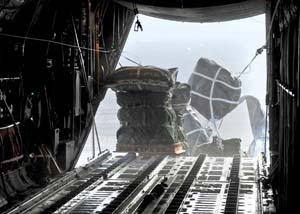 |
Supply pallets are dropped to ground forces in Afghanistan from a C-130. ( USAF photob by Lt. Col. Ken Gjone ) |
Improving USAF’s F-22s becomes even more vital in this context, as does bilateral and multilateral interoperability in the Pacific. North noted he arrived in Florida from Guam, where PACAF had just launched the bilateral exercise Cope North with Japanese forces. One of the reasons USAF has based Global Hawk ISR aircraft on Guam is because there are nations in the region that are interested in improving their ISR capabilities. The ability to share intelligence with allies will be very important in the years ahead.
“There are nations that are rapidly outsizing our numbers,” North said. “So training and technology [are] very important.”
A Modern China
Future threat environments would not be as permissive as what the US sees in Afghanistan, and the Air Force must be prepared to operate in them.
Potential “strategic adversaries” have taken advantage of their own tailored investments and have designed forces and tools to challenge the ability of the US to project military power and maneuver, North said.
As the US focused on Iraq and Afghanistan, Chinese military forces modernized significantly, he noted. In 2000, less than 10 percent of the Chinese air forces were considered “modern,” North said, as in fielding fourth generation equivalent fighters and double-digit surface-to-air missiles such as the SA-10, SA-20, and HQ-9.
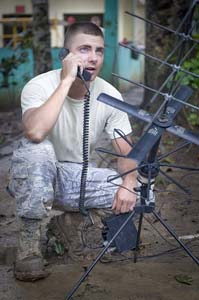 |
|
By 2009, the People’s Liberation Army Air Force boasted a fighter force considered 25 percent modernized, with aircraft such as the Su-27, the F-10, and the FB-7, and 45 percent of Chinese air defense systems considered modern. “As they structure into the next 10 to 15 years, their goal obviously is to become as modern as they can be,” North added.
USAF modernization, meanwhile, is stagnating. “How do we do our mission with a fleet that is aging, and frankly, a fleet we are flying much more than projected?” he asked.
The Air Force’s fleet age is hovering around 25 years, and even the C-17 fleet (which will close out with 221 airframes) has already racked up more than two million flight hours.
The airlifter is prized for its versatility and reliability, and has often been at the forefront of responses to various contingencies across the Pacific and the world.
Part of the surge in C-17 use came because of last year’s Iraqi drawdown and the force buildup in Afghanistan. “We’ve really maximized our asset and … that pays big dividends,” said US Transportation Command’s Gen. Duncan J. McNabb, who noted that all sensitive war materiel is flown in to Afghanistan by military airlift.
The sheer amount of movement through Iraq and Afghanistan required new and expanded overland logistics lines as well, McNabb said.
Utilizing routes from the Baltics down to the Caucasus known as the Northern Distribution Network, TRANSCOM has rerouted cargo heading into Afghanistan away from volatile Pakistani land routes. The amount of cargo going by land through Pakistan has been greatly reduced, McNabb noted. The northern network now carries 35 percent of cargo, up from 30 percent last spring.
Creative Employment
Pakistan is an ally in the war effort, but al Qaeda and the Taliban have been able to hide and operate from the vast, largely ungoverned tribal areas near the border with Afghanistan.
“The question right now is, what are we going to do to sustain the security of the United States as we work with emerging threats … while not allowing a guy to end up in Times Square with a homemade bomb?” Lt. Gen. Donald C. Wurster, head of Air Force Special Operations Command, asked rhetorically. “It doesn’t take a lot of money in certain places, but it takes some,” he added, saying USAF needs focused investment in areas such as ISR and cyber warfare capabilities.
“And we’ve got to count on the people we have to creatively employ this stuff,” Wurster said. AFSOC’s air commandos must operate in “enemy seams,” he added.
The CV-22 program, he noted, is roughly halfway through its 50-airframe production run, and is altering the ability of special operators to carry out missions due to its speed and range. Special operators don’t “knock down” integrated air defenses, he noted, but for the 85 percent of places AFSOC needs to go, it is developing a good fleet to carry out the mission. AFSOC’s 16-airframe-strong CV-22 fleet (as of February) is receiving a tough trial in Afghanistan, Wurster noted, calling the conflict “probably the most difficult environment for any vertical lift platform,” due to its altitudes, the corrosive dirt’s effects on compressor blades and power turbines, and other difficulties.
At the other end of the spectrum, USAF must keep its focus on security cooperation activities and irregular conflict outside of Southwest Asia. Wurster noted special operations forces growth has continued unabated, in the Army, Navy, and Marine Corps special operations groups. With this expansion, once the troop levels in Afghanistan begin to come down, these forces will gradually return to their traditional missions—partnering with nations around the world to hunt terrorists and other low-visibility missions. This has spurred AFSOC to examine forward basing certain key assets in Europe and the Pacific in the near future, such as the CV-22, he said.
“The question for us is, will we have the right amount of air—and the right amount postured in the right places?” he said.
“In the 20 years I’ve been doing this, I’ve never heard any [SOF customer] come up to me in the past and say ‘You know, I’ve just got too much air.’ “
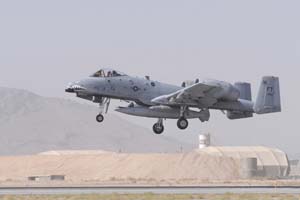 |
An A-10 lands at Kandahar Airfield, Afghanistan. Air strikes and close air support sorties are reaching record highs. ( USAF photo by TSgt. Chad Chisholm) |
A good deal of personnel and resources are tied up in Afghanistan, though. Fraser said the Air Force still has a near-term ISR focus, and is pushing to grow to 65 combat air patrols of MQ-1 Predator/MQ-9 Reaper aircraft by 2013—with the 48th CAP having stood up in February. Despite developmental issues with the Air Force’s Gorgon Stare sensor package, Fraser said he did not expect any delay in deploying the system to theater by March—and USAF anticipates learning more about the system once it deploys.
The service is normalizing MC-12 operations, Fraser said, and is examining basing options around Beale AFB, Calif., for a portion of the fleet. Upgrades to the aircraft’s ISR sensors are also needed, in order to match up with improved distributed mission operations on the ground.
Fraser also noted the Air Force is pushing replacement combat search and rescue HH-60 Pave Hawks into the theater, though they are arriving “late to need.” The Air Force just received the first two combat-loss replacement UH-60M airframes in February, and they must still undergo modifications to make them combat search and rescue capable.
The Air Force’s reserve components have become a fully operational reserve over the last 10 years. The Air National Guard and Air Force Reserve are responsive, equal partners with the active duty in Southwest Asia. “The phone never stops ringing, and it’s a worldwide commitment,” said Lt. Gen. Harry M. Wyatt III, ANG director.
He noted the Air Guard now provides 31 percent of USAF’s fighter force structure, 31 percent of its airlift, and 15 percent of its ISR capability—a number creeping higher due to the Guard’s growing involvement in the remotely piloted aircraft mission.
The Guard is able to leverage its volunteer force in emerging missions such as RPA operations which directly contribute to combat today, he noted, particularly if their civilian jobs have a fair amount of crossover. He noted that US Customs and Border Protection is paying attention to where the Air Guard is bedding down RPA units, as the civilian agency establishes its own RPA force for the purpose of border protection.
Critical Career Fields Hit
Both the Reserve and ANG depend on high volunteerism to fill their ranks and maintain their role in the Total Force. The heavy operations tempo is straining the manpower of the reserve components, and the Air Force’s move to a standard 179-day air and space expeditionary force rotation won’t affect mobilizations adversely, but some flexibility must be accounted for, both Wyatt and AFRC head Lt. Gen. Charles E. Stenner Jr. said.
Maintaining a one-to-five deployment-to-dwell ratio would be ideal, since dropping below this damages retention in critical career fields. Also, since both AFRC and ANG have benefited from supplemental war funding for operations in Iraq and Afghanistan, the influx of money has masked real shortfalls in operations budgets. Stenner said AFRC leaders are attempting to readjust, as these contingency funds gradually diminish.
High demand is straining manning for RPA operations, which is why USAF will increase crew ratios once the 65 CAP target is hit, Fraser said.
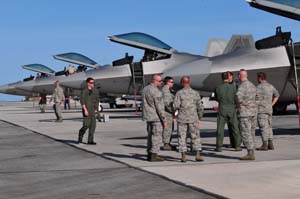 |
|
Gen. Edward A. Rice Jr., head of Air Education and Training Command, told reporters the Air Force has stood up a new office within AETC to act as a “learning office,” which will help ensure the command’s processes, courses, and curriculum are up-to-date, particularly with preparing and grooming the growing ranks of RPA operators and analysts.
AETC is currently five percent shy of meeting its throughput requirements, Rice said in February. This creates a disproportionate problem, however, because the shortages are in high priority career fields such as pararescue jumpers, cryptologists, cyber systems operators, and other career fields with long training pipelines and tough entrance requirements.
Across the enlisted force, there are signs a decade at a war footing is taking a toll, CMSAF James A. Roy said. He cited statistics, such as alcohol-related incidents hovering around 7,000 and 3,600 ground safety incidents recorded in Fiscal 2010, as well as a rise in divorce rates and abuse cases. The 2011 suicide rate has already surpassed the 100 airmen suicides recorded in Fiscal 2010, he warned.
“People matter. [A resiliency] culture is the right thing to do for our airmen, our families, and our United States Air Force,” Roy said. “Our airmen and their families are the most important resource, asset that we have. We’ve got to take that into consideration.”
US Southern Command’s Gen. Douglas M. Fraser said while he does not see a traditional military threat to the United States in his region, trafficking networks dealing in drugs, weapons, and people generate $394 billion each year and create great instability in areas of Latin America. While US assistance to Colombia over the last 10 years has helped the country clamp down on drug smuggling routes, many networks have shifted to Venezuela and other areas.
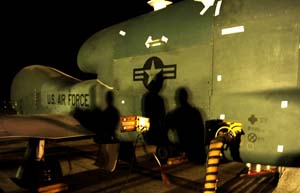 |
|
USAF must work to close the capability gap between American forces and those of the countries it is attempting to assist. Guatemala, for example, has a 1,000-man air force, but 90 percent of its expenditures are on manpower and the nation has limited air assets. For those places, we “need high reliability, low-cost systems,” such as light airlift and ISR aircraft, Fraser said. There is also opportunity in the region to use platforms such as the MC-12, an aircraft Fraser wants to see in his region.
Data Sharing Is Critical
Welsh said it is clear the Air Force must pay close attention to international integration, cooperation, and data sharing—especially, in Europe, for efforts involving missile defense.
“There are very few people who understand all the pieces of it very well,” Welsh said of missile defense. For NATO and its allies to achieve success in this mission, there needs to be better understanding of basic concepts of operations, timelines, and authorities to carry out missile intercepts. Data sharing, between the US and its allies, between allied ministers and their military leaders, is critical for missile defense to succeed in Europe, he added.
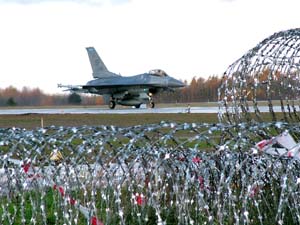 |
An F-16 from the 23rd Expeditionary Fighter Squadron taxis after a flight in Lithuania. The squadron participated in NATO’s Baltic air policing mission, which provides 24-hour security over Lithuania, Latvia, and Estonia. ( USAF photo by Capt. Thomas Crosson) |
Improving operations with allies will require revision or elimination of many of the limitations allies place on the use of force. “The NATO air policing mission that’s been going on so successfully for so many years is still impacted every day by these caveats and restrictions,” Welsh noted.
Cooperative air policing activities and more sophisticated efforts such as missile defense are closely related, he added. “The success of the NATO integrated air defense system … [makes] it very clear to me that missile defense cannot be a stand-alone mission in NATO,” Welsh said. “It has to be part of an integrated air and missile defense architecture, and that’s what we’re driving toward.”
| The Nuclear Force Needs Are Known
The average age of Air Force Global Strike Command’s three main bomber and ICBM fleets, consisting of two nuclear-capable bomber types and the Minuteman III missile, is more than 40 years old. This age “includes our ‘new’ 22-year-old B-2s,” AFGSC commander Lt. Gen. James M. Kowalski said at AFA’s Air Warfare Symposium in Orlando, Fla., Feb. 18.
Critical items such as Minuteman launch facilities are even older, with most systems and equipment dating to the early 1960s, he noted. Modernizing the Minuteman III fuse system is AFGSC’s highest funding priority over the next five years, though maintaining the edge of the B-52 and B-2 fleets is close behind, Kowalski said. Minuteman III modernization is under way to extend its viability through 2020, he noted, and GSC is working with Air Force Materiel Command to make it last until 2030, as required by Congress. During the second phase, “ICBM facilities are going to be a major focus,” assured Kowalski. The Air Force expects the B-52 and B-2 to serve through 2040 at least, when the B-52 will have been in service almost 80 years. “The B-52’s an amazing aircraft, but we’re going to need to manage the modernization and sustainment closely to keep it effective,” extending from “airspace access upgrades” such as new radar, to mundane items such as a remediated anti-skid braking system, Kowalski explained. To remain potent, the B-2 requires an extremely high frequency satellite communications upgrade to maintain proper nuclear command and control, and a modernized defensive management system. The latter is deemed “critical” to holding at threat targets considered “most dear to any adversary,” Kowalski emphasized. Continued substantive investment in the US nuclear stockpile is essential, said Gen. C. Robert Kehler, head of US Strategic Command, because the reliability of the nation’s warheads depends on the stockpile complex. From the STRATCOM commander’s perspective, “My No. 1 concern is to make sure the stockpile is safe, effective, and able to support the deterrence needs, … and that’s where, in my view, we need to make sure that the investment is going to continue,” Kehler said. It will take more than just funding some new weapons or infrastructure improvements to bring the nation’s nuclear capability back to where it needs to be, according to Kehler, who said the recent New START has put some welcome political attention on the nation’s atrophied nuclear weapons infrastructure, but just adding money will not bring the strategic deterrent up to par. “We’ve got to restore the scientific and intellectual edge and attract our best and brightest talent to this field,” Kehler adjured, noting that successful deterrence demands a “keen and current knowledge of our potential nuclear adversaries,” as well as a hearty intellectual base. US strategic forces face a wide variety of traditional and nontraditional adversaries, Kehler said. Dealing with them will demand that the neglected nuclear sustainment enterprise be refurbished at the same time nuclear forces be modernized such that they are “equipped and capable of deterring future threats.” Despite the monumental task ahead, “I am one of those people who believes that with challenge comes opportunity,” he asserted. “I am encouraged by the opportunities that we have.” New START provides a path ahead, Kehler added. —Aaron Church |